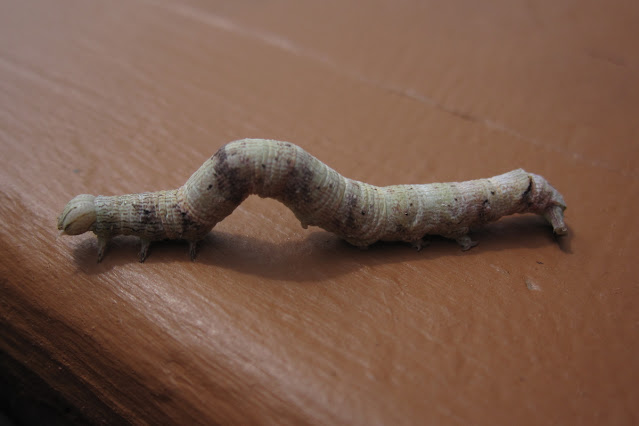With a little rain falling this week the mushrooms have been, well, mushrooming. Fungi have this interesting trait in that when the organism forms mushrooms early in the season they create all the cells needed in their fruit. (The fruit is what we see pushing up above the ground to spread their spores.) But the fruit cells are tiny and the mushroom isn't noticeable. When the rain comes, the organism takes that water and quickly pumps it into all those tiny cells, expanding them so the mushroom balloons, making it appear the mushroom grew incredibly fast. This past Tuesday morning following a good rain we found some unusual-looking mushrooms along the trail to Crockett's Ledge.
 |
| Lobster mushrooms on the Yellow Trail to Crockett's Ledge. |
I've seen orange chicken-of-the-woods mushrooms before, but never anything quite this color and shape. It didn't take a lot of digging to learn that these are called Lobster Mushrooms, though in fact, that isn't really a biological species of mushroom. There are a couple of varieties of mushrooms, usually white species of Russula or Lactarius mushrooms on which a parasitic fungus will grow. The fungus covers the outside of the mushroom and over time can contort it into these strange shapes that have the appearance of cooked lobster. [Ref: Mushroom Expert]
One author [Forager Chef] says the fungus improves the taste of these otherwise bland mushrooms, but I'm not about to eat fungus of any kind that I find in the forest! I expect to see many more varieties of mushroom popping up everywhere over the next few weeks.
While we're looking at strange organisms, how about this creepy crawler?
 |
| A Common Gray caterpillar measures the world. |
This is the larva of a geometer moth known as the Common Gray. I think the name comes from the adult moth which is a rather bland gray color though the caterpillar has some subtle but pretty pink. orange, and green hues. It also has some mean looking mouth parts which is what it uses to chew up all those leaves on our ash and aspen trees.
 |
| A nice set of chompers. |
Geometer species are commonly known as inch worms. They have legs only on their front and hind sections, so they loop themselves up and then stretch out to travel. The name geometer comes from "geo" meaning earth, and "metron" mean measure - they measure the earth as they inch along! [Ref: Thought Company]
If you receive emails from the Loon Preservation Committee you probably saw the video they posted about a brutal loon fight recorded by one of their loon-cams. After two loon deaths on Lake Wicwas this summer, one definitely killed by another loon and the second probably the loser in a hard-fought battle, this video gave me a much better understanding as to how these deaths occur. As the LPC noted, this may be distressing to watch.
A violent battle between two loons.
What appears to be a majestic, peaceful bird can become an incredibly violent animal when it comes to defending its territory, its mate, or its offspring. Happily, our nesting pair is protecting Maddie well, as just yesterday there was a group of seven loons cruising the lake, during which time Maddie was nowhere to be seen, probably hidden away with one parent in some remote cove on the lake. The most recent picture I have of the chick is from this past Monday. |
| Maddie at just over three weeks old. |
There was a small but enthusiastic group of paddlers out for the Wicwas Annual Regatta yesterday and we toured a couple of the more secluded coves around the lake. If you're out paddling near marshes in any of the local lakes over the next couple of weeks, look carefully for patches of delicate lavender flowers growing among the lily pads.
 |
| Purple Bladderwort (Utricularia purpurea) is a rootless, floating plant. |
If you don't want to paddle, you can find a huge area of purple bladderwort growing in Page Pond at the Page Pond Town Forest. Take the Multi-use (White) Trail (see map here) to the southern view point on Page Pond and you'll see them - while they last!


No comments:
Post a Comment